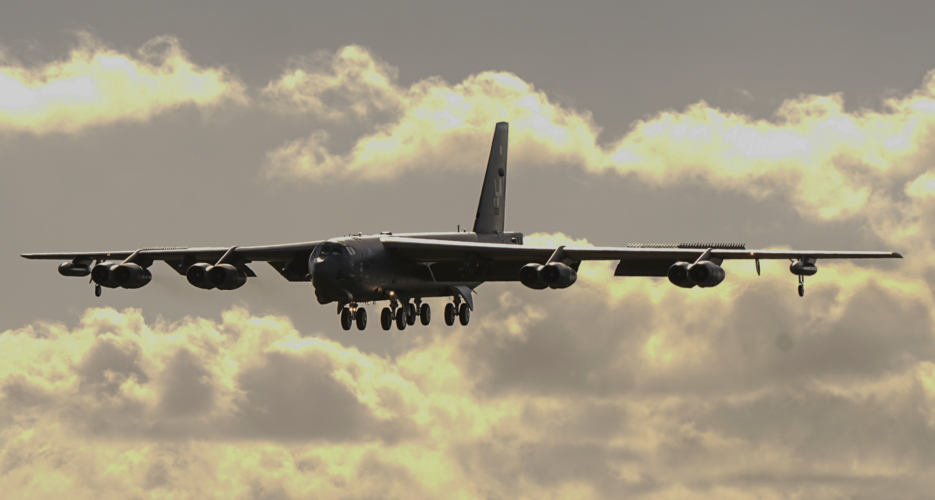The United States Forces Korea (USFK) announced on October 16 that a US strategic bomber, the B-52, is scheduled to land in a South Korean air base this week, in what is being seen as another display of force against the burgeoning threat from North Korea’s missile program.
The announcement comes at a time when South Korea is all geared to kick off its largest-ever defense exhibition, the Seoul International Aerospace and Defense Exhibition (ADEX), to bolster its arms exports. Interestingly, the B-52 bomber will perform an unprecedented flyby before landing in the country.
USFK announced that the B-52 plans to conduct two flyovers as part of a larger cross-section of US military aircraft at the exhibition. Maj. Rachel Buitrago, 7th Air Force public affairs director, said, “These flyovers, air demonstrations, and static displays, including the landing for the B-52 on the peninsula, is part of our continued pledge to promote peace, stability, and prosperity on the Korean peninsula.”
Even though the long-range bombers, capable of carrying nuclear bombs, have flown over the Korean Peninsula during joint exercises between South Korea and the US, this would be the first time the B-52 Stratofortress landed at a South Korean air base.
US bombers typically fly over the Korean Peninsula and join South Korean forces’ joint training exercises. However, they do not land there but return to Guam, Hawaii, and other US territories.
Yonhap is reporting that a USAF B-52 will land at a South Korean air base later this week.
This will be the first time that a USAF B-52 has landed in South Korea.
1. It will likely land at Osan Air Base.
2. This plan was originally being debated early this year.
3. North Korea… pic.twitter.com/uAPHtzTPbk— Global: Military-Info (@Global_Mil_Info) October 16, 2023
After North Korea’s nuclear test in 2016, strategic bombers began to land in South Korea, but they don’t seem to have done so since. The other two strategic bombers of the USAF, B-2 Spirit and B-1B Lancer, landed at Osan Airbase in Pyeongtaek, 60 kilometers south of Seoul, in September 2016.
The B-52 is the principal strategic bomber of the USAF, along with the B-2 Spirit and B-1B Lancer. It was reported in April this year that the USAF was considering a strategy that would involve regularly deploying strategic bombers in and near the Korean Peninsula, including landing them in South Korea.
This was hinted at by the US Pacific Air Forces commander, Gen. Kenneth Wilsbach, following the test of the Hwasong-18 solid-fuel intercontinental ballistic missile in mid-April.
At the time, Wilsbach told Nikkei Asia: “You might see, in the future and regularly, our bomber operations operating in and around the peninsula and perhaps even landing on the peninsula.” He referred to enhanced US-South Korea air force exercises frequently employing nuclear-capable bombers.

In July this year, the United States deployed a nuclear-armed submarine, USS Kentucky, to South Korea for the first time in four decades. The deployment aimed at deterring North Korea drew a fierce response, with the country saying it was “the most undisguised nuclear blackmail” against Pyongyang.
Moreover, the nuclear-powered USS Ronald Reagan aircraft carrier arrived at the port of Busan in the southeast last week for a five-day visit following trilateral naval exercises involving the US, South Korea, and Japan.
The latest landing of the bomber on a South Korean airbase is anticipated to show how committed the United States is to improving the regular visibility of strategic assets in the area amid increased concern over Pyongyang’s evolving nuclear threat. After two unsuccessful efforts this year, North Korea intends to relaunch a military spy satellite this month.
B-52 Bombers Have Been Hovering Over The Koreas
In December last year, South Korea and the US conducted joint drills involving a B-52 strategic bomber and F-22 stealth fighters in line with Washington’s pledge to frequently deploy “strategic assets” to deter North Korean aggression. The bombers have since participated in several drills since.
The Korean Peninsula was traversed by several B-52 Stratofortress aircraft on June 30 as part of a “combined aerial training event.” The ROK Ministry of Defense announced that the nuclear-capable bombers flew alongside F-16s and F-15Es of the USAF and F-35As and KF-16s of the Republic of Korea Air Force.
The B-52s were from Barksdale Air Force Base in Louisiana. They had recently made the first-ever B-52 landing in Indonesia as a sign of cooperation with the vital southeast Asian nation before participating in the joint drills in late June.
In the recent past and as a countermeasure to North Korea’s maturing missile program and unprecedented launches, there have been several instances of nuclear bombers flying in the skies over the Korean peninsula. The late June B-52 flight was reportedly the seventh time in six months that B-52s or B-1s flew above or near the Korean Peninsula.
Despite repeated warnings, North Korea has continued to advance its missile program, adopting new and latest technologies. “If you think back maybe five years ago, the number of launch failures they had…you’re seeing a lot less of that nowadays,” Wilsbach said in April. “They have perfected, or maybe not perfected, but certainly improved their ability to launch.”
As a response to these launches, the Washington Declaration adopted by US President Joe Biden and South Korean President Yoon Suk Yeol earlier this year affirmed that the two countries will “enhance the regular visibility of strategic assets to the Korean Peninsula” and “expand and deepen coordination between our militaries.”
The declaration, combined with Secretary of Defense Lloyd J. Austin III’s pledge to ramp up military exercises with fifth-generation fighter jets and strategic bombers, may have paved the way for the B-52, the oldest and yet the most capable strategic bomber of the USAF, to land in South Korea.
- Contact the author at sakshi.tiwari9555 (at) gmail.com
- Follow EurAsian Times on Google News